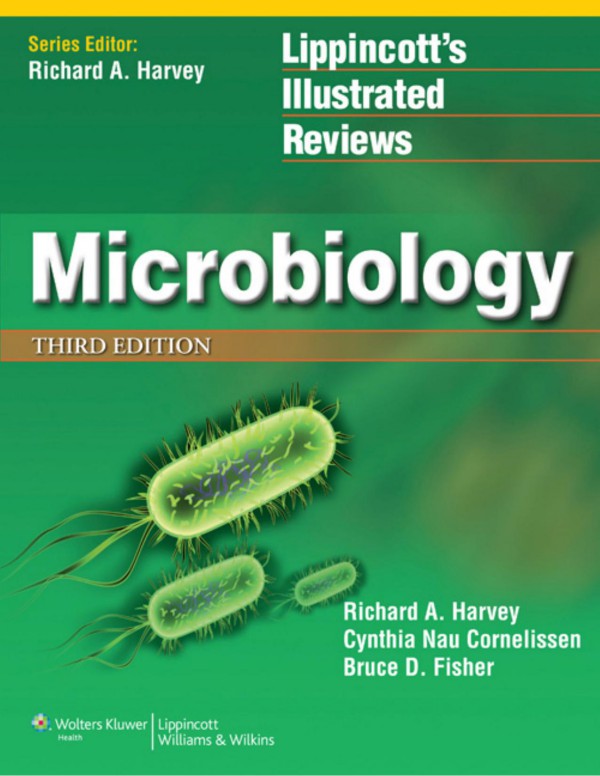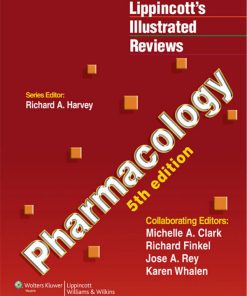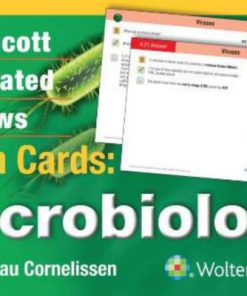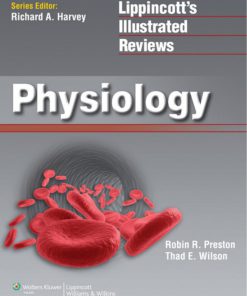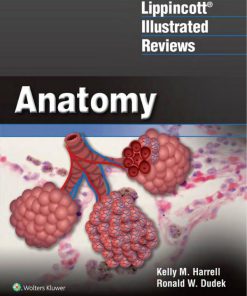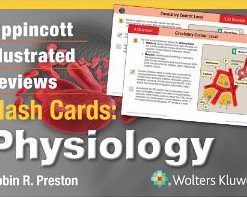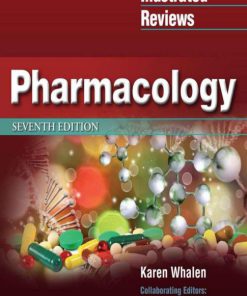Lippincott Illustrated Reviews Microbiology 3rd Edition by Richard Harvey, Cynthia N Cornelissen ISBN 1608317331 9781608317332
$50.00 Original price was: $50.00.$25.00Current price is: $25.00.
Authors:Harvey,Richard A , Series:Microbiology [19] , Tags:Microbiology; Pathology , Author sort:Harvey,Richard A , Languages:Languages:eng , Publisher:Wolters Kluwer , Comments:Comments:All rights reserved. This book is protected by copyright. No part of this book may be reproduced or transmitted in any form or by any means, including as photocopies or scanned-in or other electronic copies, or utilized by any information storage and retrieval system without written permission from the copyright owner, except for brief quotations embodied in critical articles and reviews. Materials appearing in this book prepared by individuals as part of their official duties as U.S. government employees are not covered by the above-mentioned copyright. To request permission, please contact Lippincott Williams & Wilkins at Two Commerce Square, 2001 Market Street, Philadelphia, P
Lippincott Illustrated Reviews Microbiology 3rd Edition by Richard Harvey, Cynthia N Cornelissen – Ebook PDF Instant Download/Delivery. 1608317331, 9781608317332
Full download Lippincott Illustrated Reviews Microbiology 3rd Edition after payment

Product details:
ISBN 10: 1608317331
ISBN 13: 9781608317332
Author: Richard Harvey, Cynthia N Cornelissen
A MUST READ for mastering essential concepts in microbiologyWell-known and widely used for their hallmark illustrations, Lippincott’s Illustrated Reviews bring concepts to vibrant life. Students rely on LIR for quick review, easier assimilation, and understanding of large amounts of critical, complex material. • Outline format and full-color illustrations: More than 400 color illustrations and color-coded summaries provide key information at a glance and helpful visual explanations • Illustrated case studies and questions to support USMLE prep: Expanded discussions reinforce key concepts and review questions with detailed rationales allow for self-assessment • New bookmark features mini-index of important microorganisms for quick and easy reference “Microbiology can be an overwhelming topic, but the pictures, concise descriptions, and parallel structure of each chapter helps to make the subject easier to understand and digest.” – Amelia Keaton, medical student “I think this book better meets the needs of the market because of its review chapters and disease summaries, its review questions, and its excellent photographs of clinical manifestations of microbial disease. I also found this book easier to read and study from.” – Devorah Segal, medical student FREE online! (with purchase of the text) • Interactive question bank for test-taking practice • Fully searchable eBook for studying on-the-go.
Lippincott Illustrated Reviews Microbiology 3rd Table of contents:
UNIT I: The Microbial World
1: Introduction to Microbiology
I. OVERVIEW
Figure 1.1
II. PROKARYOTIC PATHOGENS
Figure 1.2
A. Typical bacteria
Figure 1.3
B. Atypical bacteria
III. FUNGI
IV. PROTOZOA
V. HELMINTHS
VI. VIRUSES
VII. ORGANIZING THE MICROORGANISMS
A. Hierarchical organization
Figure 1.4
Figure 1.5
B. Lists of important bacteria and viruses
Figure 1.6
Figure 1.7
2: Normal Flora
I. OVERVIEW
II. THE HUMAN MICROBIOME
III. DISTRIBUTION OF NORMAL FLORA IN THE BODY
A. Skin
Figure 2.1
B. Eye
Figure 2.2
C. Mouth and nose
Figure 2.3
D. Intestinal tract
Figure 2.4
E. Urogenital tract
Figure 2.5
IV. BENEFICIAL FUNCTIONS OF NORMAL FLORA
V. HARMFUL EFFECTS OF NORMAL FLORA
Study Questions
3: Pathogenicity of Microorganisms
I. OVERVIEW
Figure 3.1
II. BACTERIAL PATHOGENESIS
Figure 3.2
A. Virulence factors
Figure 3.3
B. Host-mediated pathogenesis
C. Antigenic variation
D. Which is the pathogen?
Figure 3.4
E. Infections in human populations
III. VIRAL PATHOGENESIS
A. Viral pathogenesis at the cellular level
Figure 3.5
B. Initial infections
Figure 3.6
Figure 3.7
Study Questions
4: Diagnostic Microbiology
I. OVERVIEW
Figure 4.1
II. PATIENT HISTORY AND PHYSICAL EXAMINATION
III. DIRECT VISUALIZATION OF THE ORGANISM
A. Gram stain
Figure 4.2
B. Acid-fast stain
Figure 4.3
C. India ink preparation
Figure 4.4
D. Potassium hydroxide preparation
Figure 4.5
IV. GROWING BACTERIA IN CULTURE
A. Specimen collection
Figure 4.6
B. Growth requirements
C. Oxygen requirements
D. Media
Figure 4.7
V. IDENTIFICATION OF BACTERIA
A. Single-enzyme tests
Figure 4.8
B. Automated systems
Figure 4.9
C. Tests based on the presence of metabolic pathways
Figure 4.10
VI. IMMUNOLOGIC DETECTION OF MICROORGANISMS
A. Detection of microbial antigen with known antiserum
B. Identification of serum antibodies
Figure 4.11
C. Other tests used to identify serum antigens or antibodies
Figure 4.12
Figure 4.13
VII. NUCLEIC ACID –BASED TESTS
A. Direct detection of pathogens without target amplification
B. Nucleic acid amplification for diagnosis
Figure 4.14
C. DNA microarrays
VIII. SUSCEPTIBILITY TESTING
A. Disk-diffusion method
Figure 4.15
B. Minimal inhibitory concentration
Figure 4.16
C. Bacteriostatic versus bactericidal drugs
Figure 4.17
Study Questions
5: Vaccines and Antimicrobial Agents
I. OVERVIEW
Figure 5.1
II. PASSIVE IMMUNIZATION
Figure 5.2
III. ACTIVE IMMUNIZATION
A. Formulations for active immunization
Figure 5.3
Figure 5.4
Figure 5.5
B. Types of immune response to vaccines
C. Effect of age on efficacy of immunization
D. Adverse reactions to active vaccination
Figure 5.6
IV. BACTERIAL VACCINES
Figure 5.7
A. Less common bacterial pathogens
V. VIRAL VACCINES
A. Hepatitis A
B. Hepatitis B
Figure 5.8
C. Varicella zoster
D. Polio
E. Influenza
F. Measles, mumps, and rubella
J. Human papillomavirus vaccine
VI. DNA VACCINES
Figure 5.9
VII. OVERVIEW OF ANTIMICROBIAL AGENTS
VIII. AGENTS USED TO TREAT BACTERIAL INFECTIONS
Figure 5.10
A. Penicillins
Figure 5.11
B. Cephalosporins
Figure 5.12
C. Tetracyclines
Figure 5.13
D. Aminoglycosides
Figure 5.14
E. Macrolides
Figure 5.15
F. Fluoroquinolones
Figure 5.16
G. Carbapenems
Figure 5.17
H. Other important antibacterial agents
IX. DRUG RESISTANCE
A. Genetic alterations leading to drug resistance
B. Altered expression of proteins in drug-resistant organisms
Figure 5.18
X. AGENTS USED TO TREAT VIRAL INFECTIONS
A. Organization of viruses
Figure 5.19
Figure 5.20
B. Treatment of herpesvirus infections
C. Treatment of acquired immunodeficiency syndrome
D. Treatment of viral hepatitis
E. Treatment of influenza
Study Questions
UNIT II: Bacteria
6: Bacterial Structure, Growth, and Metabolism
I. OVERVIEW
Figure 6.1
II. THE CELL ENVELOPE
A. Cytoplasmic membrane
B. Peptidoglycan
Figure 6.2
C. Differences between gram-positive and gram-negative cell walls
Figure 6.3
D. The external capsule and glycocalyx
E. Appendages
Figure 6.4
F. Antigenic variation
III. SPORES AND SPORULATION
Figure 6.5
A. Sporulation
B. Spore germination
C. Medical significance of sporulation
IV. GROWTH AND METABOLISM
A. Characteristics of bacterial growth
Figure 6.6
Figure 6.7
B. Energy production
Figure 6.8
C. Peptidoglycan synthesis
Figure 6.9
Figure 6.10
Study Questions
7: Bacterial Genetics
I. OVERVIEW
II. THE BACTERIAL GENOME
Figure 7.1
A. The chromosome
B. Pathogenicity islands
C. Plasmids
III. BACTERIOPHAGE
Figure 7.2
Figure 7.3
A. Virulent phage
B. Temperate phage
C. Lysogenic bacteria
IV. GENE TRANSFER
A. Conjugation
Figure 7.4
B. Transduction
Figure 7.5
C. Transformation
V. GENETIC VARIATION
A. Mutations
B. Mobile genetic elements
Figure 7.6
C. Mechanisms of acquired antibiotic resistance
Figure 7.7
VI. GENE REGULATION
A. Negative control (repression)
Figure 7.8
B. Positive control (activation)
C. Modifications of RNA polymerase specificity
Study Questions
8: Staphylococci
I. OVERVIEW
Figure 8.1
II. GENERAL FEATURES
Figure 8.2
III. STAPHYLOCOCCUS AUREUS
Figure 8.3
A. Epidemiology
B. Pathogenesis
Figure 8.4
C. Clinical significance
Figure 8.5
Figure 8.6
D. Laboratory identification
Figure 8.7
E. Immunity
F. Treatment
Figure 8.8
Figure 8.9
G. Prevention
IV. COAGULASE-NEGATIVE STAPHYLOCOCCI
A. Staphylococcus epidermidis
Figure 8.10
B. Staphylococcus saprophyticus
Figure 8.11
Figure 8.12
Study Questions
9: Streptococci
I. OVERVIEW
Figure 9.1
II. CLASSIFICATION OF STREPTOCOCCI
A. Hemolytic properties on blood agar
B. Serologic (Lancefield) groupings
Figure 9.2
III. GROUP A β-HEMOLYTIC STREPTOCOCCI
A. Structure and physiology
Figure 9.3
Figure 9.4
B. Epidemiology
C. Pathogenesis
D. Clinical significance
Figure 9.5
E. Laboratory identification
F. Treatment
Figure 9.6
G. Prevention
IV. GROUP B β-HEMOLYTIC STREPTOCOCCI
V. STREPTOCOCCUS PNEUMONIAE (PNEUMOCOCCUS)
Figure 9.7
Figure 9.8
A. Epidemiology
B. Pathogenesis
Figure 9.9
C. Clinical significance
Figure 9.10
D. Laboratory identification
Figure 9.11
E. Treatment
F. Prevention
Figure 9.12
VI. ENTEROCOCCI
Figure 9.13
A. Epidemiology
B. Diseases
C. Laboratory identification
D. Treatment
Figure 9.14
E. Prevention
VII. NONENTEROCOCCAL GROUP D STREPTOCOCCI
VIII. VIRIDANS STREPTOCOCCI
Figure 9.15
Figure 9.16
Study Questions
10: Gram-positive Rods
I. OVERVIEW
Figure 10.1
II. CORYNEBACTERIA
A. Corynebacterium diphtheriae
Figure 10.2
Figure 10.3
Figure 10.4
Figure 10.5
B. Diphtheroids
III. BACILLUS SPECIES
A. Bacillus anthracis
Figure 10.6
Figure 10.7
B. Other bacillus species
IV. LISTERIA
A. Epidemiology
B. Pathogenesis
Figure 10.8
C. Clinical significance
D. Laboratory identification
Figure 10.9
E. Treatment and prevention
V. OTHER NON-SPORE-FORMING, GRAM-POSITIVE RODS
Study Questions
11: Neisseriae
I. OVERVIEW
Figure 11.1
II. NEISSERIA GONORRHOEAE
Figure 11.2
A. Structure
Figure 11.3
B. Pathogenesis
C. Clinical significance
Figure 11.4
Figure 11.5
Figure 11.6
D. Laboratory identification
Figure 11.7
E. Treatment and prevention
III. NEISSERIA MENINGITIDIS
A. Structure
Figure 11.8
Figure 11.9
B. Epidemiology
Figure 11.10
C. Pathogenesis
D. Clinical significance
Figure 11.11
E. Laboratory identification
Figure 11.12
Figure 11.13
F. Treatment and prevention
Figure 11.14
Figure 11.15
IV. MORAXELLA
V. ACINETOBACTER
Study Questions
12: Gastrointestinal Gram-negative Rods
I. OVERVIEW
Figure 12.1
II. ESCHERICHIA COLI
A. Structure and physiology
Figure 12.2
B. Clinical significance: intestinal disease
Figure 12.3
Figure 12.4
C. Clinical significance: extraintestinal disease
D. Laboratory identification
E. Prevention and treatment
Figure 12.5
III. SALMONELLA
A. Epidemiology
B. Pathogenesis
Figure 12.6
C. Clinical significance
D. Laboratory identification
Figure 12.7
E. Treatment and prevention
IV. CAMPYLOBACTER
Figure 12.8
A. Epidemiology
B. Pathogenesis and clinical significance
Figure 12.9
C. Laboratory identification
D. Treatment and prevention
Figure 12.10
V. SHIGELLA
A. Epidemiology
B. Pathogenesis and clinical significance
Figure 12.11
C. Laboratory identification
D. Treatment and prevention
Figure 12.12
VI. VIBRIO
A. Epidemiology
B. Pathogenesis
Figure 12.13
C. Clinical significance
D. Laboratory identification
E. Treatment and prevention
Figure 12.14
F. Vibrio parahaemolyticus and other halophilic, noncholera vibrios
VII. YERSINIA
A. Pathogenesis and clinical significance
B. Laboratory identification
C. Treatment and prevention
Figure 12.15
VIII. HELICOBACTER
Figure 12.16
A. Pathogenesis
Figure 12.17
B. Clinical significance
C. Laboratory identification
D. Treatment and prevention
Figure 12.18
IX. OTHER ENTEROBACTERIACEAE
A. Enterobacter
B. Klebsiella
Figure 12.19
C. Serratia
D. Proteus, Providencia, and Morganella
Study Questions
13: Other Gram-negative Rods
I. OVERVIEW
Figure 13.1
II. HAEMOPHILUS
Figure 13.2
A. Epidemiology
B. Pathogenesis
Figure 13.3
C. Clinical significance
Figure 13.4
D. Laboratory identification
Figure 13.5
E. Treatment
F. Prevention
III. BORDETELLA
A. Epidemiology
B. Pathogenesis
Figure 13.6
C. Clinical significance
Figure 13.7
D. Laboratory identification
E. Treatment
F. Prevention
Figure 13.8
Figure 13.9
IV. LEGIONELLA
A. Epidemiology
B. Pathogenesis
C. Clinical significance
Figure 13.10
D. Laboratory identification
Figure 13.11
E. Treatment
V. PSEUDOMONAS
A. Pathogenesis
B. Clinical significance
Figure 13.12
C. Laboratory identification
Figure 13.13
D. Treatment and Prevention
VI. BRUCELLA
A. Epidemiology
Figure 13.14
B. Pathogenesis
C. Clinical significance
D. Laboratory identification
E. Treatment
Figure 13.15
VII. FRANCISELLA TULARENSIS
Figure 13.16
A. Epidemiology
B. Pathogenesis
C. Clinical significance
Figure 13.17
D. Laboratory identification
E. Treatment
Figure 13.18
VIII. YERSINIA PESTIS
A. Epidemiology
Figure 13.19
B. Pathogenesis
C. Clinical significance
Figure 13.20
D. Laboratory identification
E. Treatment and prevention
Figure 13.21
IX. BARTONELLA
A. Bartonella quintana
Figure 13.22
B. Bartonella henselae
Figure 13.23
X. PASTEURELLA
A. Epidemiology
B. Clinical significance
C. Laboratory identification
D. Treatment
Figure 13.24
Study Questions
14: Clostridia and Other Anaerobic Rods
I. OVERVIEW
Figure 14.1
II. CLOSTRIDIA
A. General features of clostridia
Figure 14.2
B. Clostridium perfringens
Figure 14.3
Figure 14.4
Figure 14.5
C. Clostridium botulinum
Figure 14.6
D. Clostridium tetani
Figure 14.7
Figure 14.8
E. Clostridium difficile
Figure 14.9
Figure 14.10
III. ANAEROBIC GRAM-NEGATIVE RODS
Figure 14.11
A. Bacteroides
Study Questions
15: Spirochetes
I. OVERVIEW
Figure 15.1
II. STRUCTURAL FEATURES OF SPIROCHETES
Figure 15.2
III. TREPONEMA PALLIDUM
Figure 15.3
A. Pathogenesis
B. Clinical significance
Figure 15.4
Figure 15.5
C. Laboratory identification
D. Treatment and prevention
Figure 15.6
Figure 15.7
IV. BORRELIA BURGDORFERI
A. Pathogenesis
Figure 15.8
B. Clinical significance
Figure 15.9
C. Laboratory identification
D. Treatment and prevention
V. RELAPSING FEVER SPIROCHETES
A. Pathogenesis
Figure 15.10
B. Clinical significance
Figure 15.11
C. Diagnosis and treatment
Figure 15.12
VI. LEPTOSPIRA INTERROGANS
Figure 15.13
A. Epidemiology and pathogenesis
B. Clinical significance
C. Diagnosis and treatment
Figure 15.14
Study Questions
16: Mycoplasma
I. OVERVIEW
Figure 16.1
II. GENERAL FEATURES OF MYCOPLASMAS
Figure 16.2
A. Physiology
B. Colony production
III. MYCOPLASMA PNEUMONIAE
A. Pathogenesis
B. Clinical significance
Figure 16.3
C. Immunity
D. Laboratory identification
E. Treatment
IV. GENITAL MYCOPLASMAS
A. Mycoplasma hominis and Ureaplasma urealyticum
Figure 16.4
B. Mycoplasma genitalium
V. OTHER MYCOPLASMAS
Figure 16.5
Study Questions
17: Chlamydiae
I. OVERVIEW
Figure 17.1
II. GENERAL FEATURES OF CHLAMYDIAE
Figure 17.2
A. Physiology
B. Pathogenesis
Figure 17.3
C. Laboratory identification
III. CHLAMYDIA TRACHOMATIS
Figure 17.4
A. Clinical significance
Figure 17.5
B. Laboratory identification
Figure 17.6
C. Treatment and prevention
IV. CHLAMYDIA PSITTACI
Figure 17.7
Figure 17.8
V. CHLAMYDIA PNEUMONIAE
Study Questions
18: Mycobacteria and Actinomycetes
I. OVERVIEW
Figure 18.1
II. MYCOBACTERIA
Figure 18.2
A. Mycobacterium tuberculosis
Figure 18.3
Figure 18.4
Figure 18.5
Figure 18.6
Figure 18.7
Figure 18.8
Figure 18.9
Figure 18.10
Figure 18.11
B. Mycobacterium leprae
Figure 18.12
Figure 18.13
Figure 18.14
III. ACTINOMYCETES
Figure 18.15
A. Actinomyces israelii
B. Nocardia asteroides and Nocardia brasiliensis
Figure 18.16
IV. ATYPICAL MYCOBACTERIA
Study Questions
19: Rickettsia, Erhlichia, Anaplasma and Coxiella
I. OVERVIEW
Figure 19.1
II. RICKETTSIA
Figure 19.2
A. Physiology
B. Pathogenesis
Figure 19.3
C. Clinical significance—spotted fever group
Figure 19.4
C. Clinical significance—typhus group
D. Laboratory identification
E. Treatment
Figure 19.5
F. Prevention of infection
III. EHRLICHIA AND ANAPLASMA
A. Clinical significance
Figure 19.6
B. Laboratory identification
C. Treatment
IV. COXIELLA
A. Clinical significance
B. Laboratory identification
C. Treatment and prevention
Study Questions
UNIT III: Fungi and Parasites
20: Fungi
I. OVERVIEW
Figure 20.1
II. CHARACTERISTICS OF MAJOR FUNGAL GROUPS
A. Cell wall and membrane components
B. Habitat and nutrition
C. Modes of fungal growth
Figure 20.2
D. Sporulation
Figure 20.3
E. Laboratory identification
Figure 20.4
III. CUTANEOUS (SUPERFICIAL) MYCOSES
A. Epidemiology
B. Pathology
C. Clinical significance
Figure 20.5
D. Treatment
IV. SUBCUTANEOUS MYCOSES
A. Epidemiology
B. Clinical significance
Figure 20.6
Figure 20.7
V. SYSTEMIC MYCOSES
A. Epidemiology and pathology
Figure 20.8
B. Clinical significance
Figure 20.9
Figure 20.10
Figure 20.11
C. Laboratory identification
D. Treatment
VI. OPPORTUNISTIC MYCOSES
Figure 20.12
A. Candidiasis (candidosis)
Figure 20.13
Figure 20.14
B. Cryptococcosis
Figure 20.15
C. Aspergillosis
Figure 20.16
Figure 20.17
D. Mucormycosis
Figure 20.18
E. Pneumocystis jiroveci
Figure 20.19
Figure 20.20
Study Questions
21: Protozoa
I. OVERVIEW
Figure 21.1
II. CLASSIFICATION OF CLINICALLY IMPORTANT PROTOZOA
Figure 21.2
A. Amebas
B. Flagellates
C. Ciliates
D. Sporozoa
III. INTESTINAL PROTOZOAL INFECTIONS
A. Amebic dysentery (Entamoeba histolytica)
Figure 21.3
Figure 21.4
B. Giardiasis (Giardia lamblia)
Figure 21.5
C. Cryptosporidiosis (Cryptosporidium species)
D. Balantidiasis (Balantidium coli)
Figure 21.6
IV. UROGENITAL TRACT INFECTION: TRICHOMONIASIS
Figure 21.7
Figure 21.8
V. BLOOD AND TISSUE PROTOZOAL INFECTIONS
A. Malaria (Plasmodium falciparum and other species)
Figure 21.9
Figure 21.10
B. Toxoplasmosis (Toxoplasma gondii)
C. Trypanosomiasis (various trypanosome species)
Figure 21.11
Figure 21.12
D. Leishmaniasis (various Leishmania species)
Figure 21.13
Figure 21.14
E. Amebic encephalitis (Naegleria fowleri, Acanthamoeba castellanii, and Balamuthia mandrillaris)
F. Babesiosis (Babesia microti)
Figure 21.15
Study Questions
22: Helminths
I. OVERVIEW
Figure 22.1
II. CESTODES
Figure 22.2
Figure 22.3
III. TREMATODES
A. Hermaphroditic flukes
B. Sexual flukes (schistosomes)
Figure 22.4
Figure 22.5
IV. NEMATODES
Figure 22.6
Figure 22.7
Figure 22.8
Figure 22.9
Study Questions
UNIT IV: Viruses
23: Introduction to the Viruses
I. OVERVIEW
Figure 23.1
II. CHARACTERISTICS USED TO DEFINE VIRUS FAMILIES, GENERA, AND SPECIES
Figure 23.2
A. Genome
Figure 23.3
B. Capsid symmetry
Figure 23.4
Figure 23.5
C. Envelope
Figure 23.6
III. VIRAL REPLICATION: THE ONE-STEP GROWTH CURVE
Figure 23.7
A. Eclipse period
B. Exponential growth
IV. STEPS IN THE REPLICATION CYCLES OF VIRUSES
A. Adsorption
Figure 23.8
B. Penetration
Figure 23.9
Figure 23.10
C. Uncoating
D. Mechanisms of DNA virus genome replication
Figure 23.11
E. Mechanisms of RNA virus genome replication
Figure 23.12
Figure 23.13
Figure 23.14
Figure 23.15
F. Assembly and release of progeny viruses
Figure 23.16
G. Effects of viral infection on the host cell
Figure 23.17
Study Questions
24: Nonenveloped DNA Viruses
I. OVERVIEW
Figure 24.1
II. INTRODUCTION TO THE PAPOVAVIRDAE
III. PAPOVAVIRIDAE: SUBFAMILY PAPILLOMAVIRINAE
A. Epidemiology
B. Pathogenesis
Figure 24.2
C. Clinical significance
Figure 24.3
Figure 24.4
D. Laboratory identification
E. Treatment and prevention
Figure 24.5
IV. PAPOVAVIRIDAE: SUBFAMILY POLYOMAVIRINAE
A. Epidemiology and pathogenesis
B. Clinical significance
Figure 24.6
Figure 24.7
C. Laboratory identification
D. Treatment and prevention
V. ADENOVIRIDAE
Figure 24.8
A. Epidemiology and pathogenesis
B. Structure and replication
C. Clinical significance
Figure 24.9
D. Laboratory identification
E. Treatment and prevention
VI. PARVOVIRIDAE
A. Epidemiology and pathogenesis
Figure 24.10
B. Clinical significance
Figure 24.11
C. Laboratory identification
D. Treatment and prevention
Study Questions
25: Enveloped DNA Viruses
I. OVERVIEW
Figure 25.1
II. HERPESVIRIDAE: STRUCTURE AND REPLICATION
A. Structure of herpesviruses
Figure 25.2
B. Classification of herpesviruses
C. Replication of the herpesviruses
Figure 25.3
III. Herpes simplex virus, types 1 and 2
A. Epidemiology and pathogenesis
B. Clinical significance
Figure 25.4
Figure 25.5
Figure 25.6
C. Laboratory identification
D. Treatment
Figure 25.7
Figure 25.8
Figure 25.9
E. Prevention
IV. VARICELLA-ZOSTER VIRUS
A. Epidemiology and pathogenesis
Figure 25.10
B. Clinical significance
Figure 25.11
Figure 25.12
C. Laboratory identification
D. Treatment
Figure 25.13
E. Prevention
V. HUMAN CYTOMEGALOVIRUS
Figure 25.14
A. Epidemiology and pathogenesis
B. Clinical significance
Figure 25.15
Figure 25.16
C. Laboratory identification
D. Treatment and prevention
Figure 25.17
VI. HUMAN HERPESVIRUS TYPES 6 AND 7
A. Epidemiology and pathogenesis
B. Clinical significance
Figure 25.18
Figure 25.19
Figure 25.20
C. Laboratory identification
D. Treatment and prevention
VII. HUMAN HERPESVIRUS TYPE 8
VIII. EPSTEIN-BARR VIRUS
A. Epidemiology and pathogenesis
Figure 25.21
B. Clinical significance
Figure 25.22
Figure 25.23
C. Laboratory identification
Figure 25.24
D. Treatment and prevention
Figure 25.25
IX. POXVIRIDAE
A. Structure and classification of the family
B. Replication of the poxviruses
C. Epidemiology and clinical significance
Figure 25.26
D. Laboratory identification
E. Treatment and prevention
F. Smallpox as a biologic weapon
Study Questions
26: Hepatitis B and Hepatitis D (Delta) Viruses
I. OVERVIEW
Figure 26.1
Figure 26.2
II. HEPADNAVIRIDAE
A. Structure and replication of hepatitis B virus
Figure 26.3
Figure 26.4
B. Transmission
C. Pathogenesis
D. Clinical significance: acute disease
Figure 26.5
Figure 26.6
Figure 26.7
Figure 26.8
E. Clinical significance: chronic disease
Figure 26.9
F. Laboratory identification
G. Treatment
Figure 26.10
H. Prevention
Figure 26.11
III. HEPATITIS D VIRUS (DELTA AGENT)
A. Structure and replication
Figure 26.12
B. Transmission and pathogenesis
C. Clinical significance
Figure 26.13
D. Laboratory identification
E. Treatment and prevention
Study Questions
27: Positive-strand RNA Viruses
I. OVERVIEW
Figure 27.1
II. PICORNAVIRIDAE
Figure 27.2
A. Enterovirus
Figure 27.3
Figure 27.4
B. Rhinovirus
Figure 27.5
C. Hepatovirus
Figure 27.6
Figure 27.7
III. CALICIVIRIDAE
A. Caliciviruses
B. Hepatitis E virus (HEV)
IV. TOGAVIRIDAE
A. Alphavirus
B. Rubivirus
Figure 27.8
V. FLAVIVIRIDAE
A. Flavivirus
Figure 27.9
B. Hepatitis C viruses
Figure 27.10
Figure 27.11
Figure 27.12
VI. CORONAVIRIDAE
Study Questions
28: Retroviruses and AIDS
I. OVERVIEW
Figure 28.1
II. RETROVIRUS STRUCTURE
Figure 28.2
III. HUMAN IMMUNODEFICIENCY VIRUS
Figure 28.3
Figure 28.4
A. Organization of the HIV genome
Figure 28.5
B. HIV replication
Figure 28.6
Figure 28.7
Figure 28.8
Figure 28.9
C. Transmission of HIV
Figure 28.10
Figure 28.11
D. Pathogenesis and clinical significance of HIV infection
Figure 28.12
Figure 28.13
Figure 28.14
Figure 28.15
E. Laboratory identification
F. Treatment
Figure 28.16
Figure 28.17
Figure 31.18
G. Prevention
IV. HUMAN T-CELL LYMPHOTROPIC VIRUSES, TYPES 1 AND 2
A. Transmission of HTLV
B. Pathogenesis and clinical significance of adult T-cell leukemia
Figure 28.19
Figure 28.20
C. Pathogenesis and clinical significance of HTLV-associated myelopathy/tropical spastic paraparesis
D. Other manifestions of HTLV-1 infection.
E. Laboratory identification
F. Treatment and prevention
Study Questions
29: Negative-strand RNA Viruses
I. OVERVIEW
Figure 29.1
II. RHABDOVIRIDAE
Figure 29.2
A. Epidemiology
Figure 29.3
B. Viral replication
C. Pathology
D. Laboratory identification
Figure 29.4
E. Treatment and prevention
III. PARAMYXOVIRIDAE
Figure 29.5
A. Paramyxovirus
B. Rubulavirus
Figure 29.6
C. Morbillivirus
Figure 29.7
Figure 29.8
Figure 29.9
D. Pneumovirus
IV. ORTHOMYXOVIRIDAE
A. Structure
Figure 29.10
B. Viral replication
Figure 29.11
Figure 29.12
C. Pathology and clinical significance
Figure 29.13
D. Epidemiology
E. Influenza virus immunology
Figure 29.14
Figure 29.15
F. Diagnosis
G. Treatment and prevention
V. FILOVIRIDAE
Figure 29.16
VI. BUNYAVIRIDAE
Figure 29.17
VII. ARENAVIRIDAE
Study Questions
30: Double-stranded RNA Viruses: Reoviridae
I. OVERVIEW
Figure 30.1
II. ROTAVIRUS
Figure 30.2
A. Epidemiology
B. Viral replication
Figure 30.3
C. Clinical significance
Figure 30.4
D. Laboratory identification
E. Treatment and prevention
Study Questions
31: Unconventional Infectious Agents
I. OVERVIEW
Figure 31.1
Figure 31.2
II. PRIONS
A. Presence of prion protein in normal mammalian brain
Figure 31.3
B. Epidemiology
C. Pathology
D. Clinical significance
Figure 31.4
E. Laboratory identification
F. Treatment and prevention
Study Questions
UNIT V: Clinical Microbiology Review
32: Quick Review of Clinically Important Microorganisms
I. OVERVIEW
FIGURE 32.1
FIGURE 32.2
BACTERIA
Chlamydia pneumonia
Chlamydia psittaci
Chlamydia trachomatis
Clostridium botulinum
Clostridium difficile
Clostridium perfringens
Clostridium tetani
Mycobacterium leprae
Mycobacterium tuberculosis
Mycoplasma pneumoniae
Neisseria gonorrhoeae
Neisseria meningitidis
Salmonella enterica serovar Typhi
Salmonella enterica serovar Typhimurium
Staphylococcus aureus
Staphylococcus epidermidis
Staphylococcus saprophyticus
Streptococcus agalactiae
Streptococcus pneumoniae
Streptococcus pyogenes
VIRUSES
Hepatitis B virus
Epstein-Barr virus
Herpes simplex virus, type 1
Herpes simplex virus, type 2
Human cytomegalovirus
Varicella-zoster virus
Measles virus
Mumps virus
Parainfluenza virus
Respiratory syncytial virus
Coxsackievirus
Hepatitis A virus
Poliovirus
33: Disease Summaries
I. OVERVIEW
Figure 33.1
II. SEXUALLY TRANSMITTED DISEASES
Figure 33.2
III. FOODBORNE ILLNESS (bacterial)
Figure 33.3
IV. URINARY TRACT INFECTIONS
Figure 33.4
V. MENINGITIS
Figure 33.5
VI. HEPATITIS
Figure 33.6
Figure 33.7
VII. COMMUNITY-ACQUIRED PNEUMONIA
VIII. ATYPICAL PNEUMONIA
Figure 33.8
IX. DISEASES OF THE EYE
Figure 33.9
X. OPPORTUNISTIC INFECTIONS OF HIV
Figure 33.10
Figure 33.11
XI. BACTERIAL SINUSITIS
Figure 33.12
XII. OTITIS MEDIA
34: Illustrated Case Studies
I. OVERVIEW
Case 1: Man with necrosis of the great toe
Figure 34.1
Figure 34.2
Case 2: Adult conjunctivitis
Figure 34.3
Figure 34.4
Figure 34.5
Case 3: Gas within a bulla
Figure 34.6
Figure 34.7
Figure 34.8
Case 4: Man with a rash
Figure 34.9
Figure 34.10
Case 5: Woman with cough
Figure 34.11
Case 6: Woman with swollen wrist
Figure 34.12
Figure 34.13
Case 7: Man with endophthalmitis
Figure 34.14
Figure 34.15
Figure 34.16
Figure 34.17
Figure 34.18
Case 8: Man with fever and paraplegia
Figure 34.19
Case 9: Woman with fever
Figure 34.20
Case 10: Man in coma
Figure 34.21
Figure 34.22
Case 11: Man with recurrent fever
Figure 34.23
Case 12: Woman from Ecuador with cough
Figure 34.24
Figure 34.25
Case 13: Woman with headache
Figure 34.26
Case 14: Hematuria in an Egyptian-born man
Figure 34.27
Case 15: Multisystem illness with skin changes
Figure 34.28
Case 16: Diarrhea acquired in South America
Figure 34.29
Case 17: Painful Rash
Figure 34.30
Back Matter
Information contained in this: Index
People also search for Lippincott Illustrated Reviews Microbiology 3rd:
lippincott illustrated reviews
lippincott illustrated reviews neuroscience
lippincott illustrated reviews integrated systems
lippincott’s illustrated q&a review of neuroscience
immunology books best

